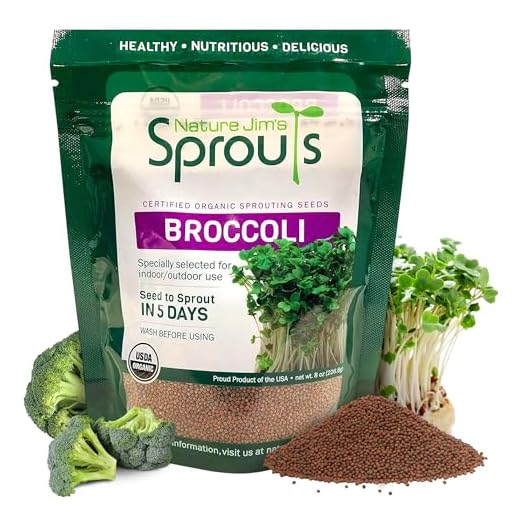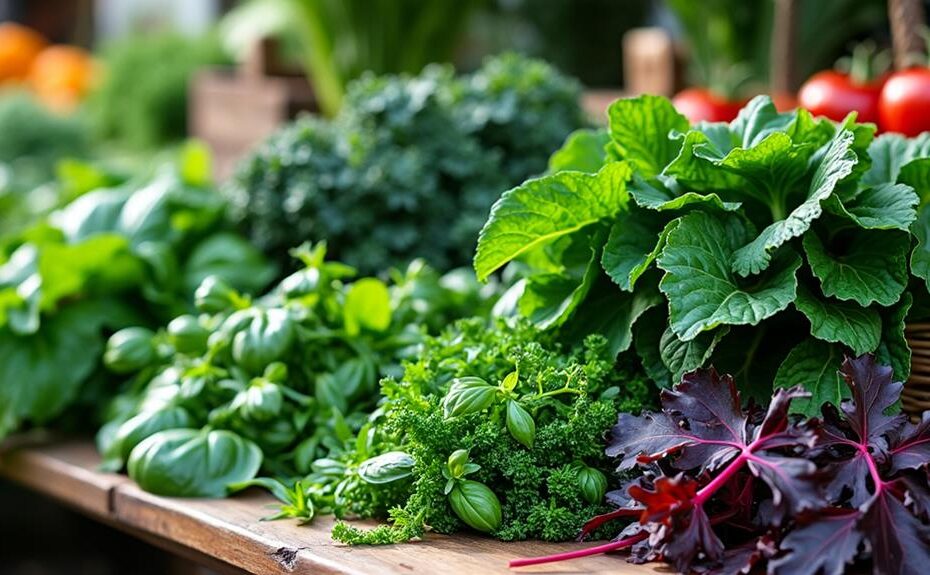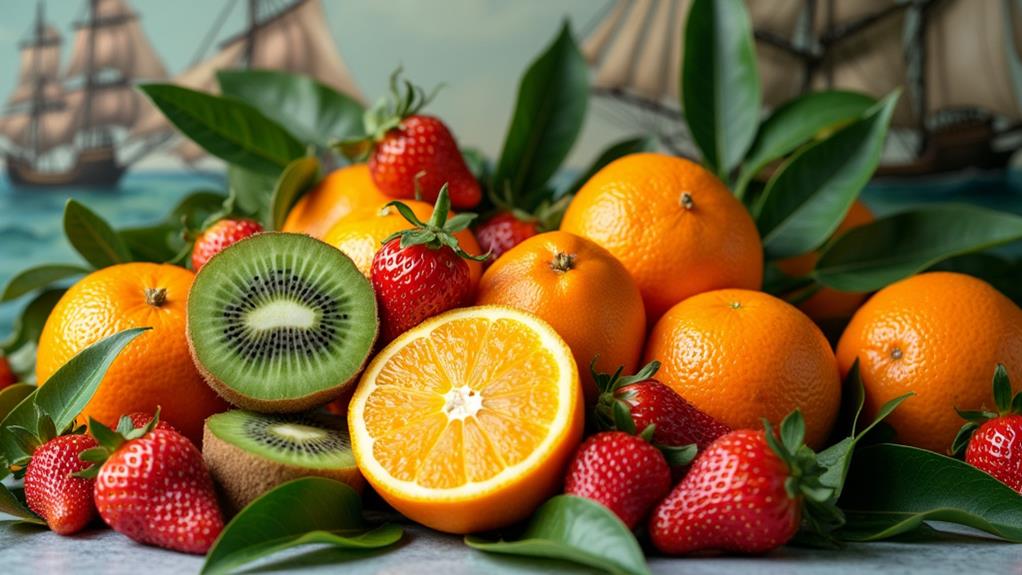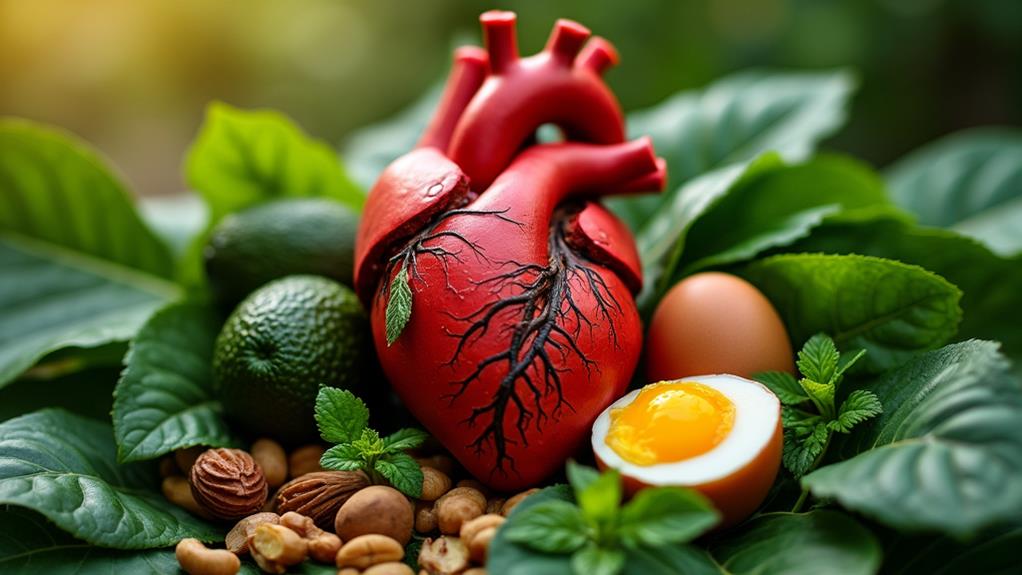







You'll find vitamin K1 primarily in dark leafy greens, such as kale, spinach, and collard greens, which are among the richest sources. Cruciferous vegetables like broccoli and Brussels sprouts also provide significant amounts. Fruits like avocados and kiwis contribute to your intake, as well as legumes including green peas and chickpeas. Nuts and seeds, while offering smaller quantities, can enhance absorption when paired with healthy fats. Incorporating these foods into your diet not only boosts your vitamin K1 levels but also supports overall health, hinting at more nutritional insights worth exploring further.
Key Takeaways
- Dark leafy greens, like kale and collard greens, are the richest sources of vitamin K1, providing significant daily value per serving.
- Cruciferous vegetables such as broccoli and Brussels sprouts also deliver substantial amounts of vitamin K1, supporting overall health.
- Fruits including avocados, kiwis, and blueberries contribute to vitamin K1 intake while adding flavor and nutrients.
- Legumes, such as green peas and chickpeas, offer moderate amounts of vitamin K1 along with protein and fiber benefits.
- Nuts and seeds, while providing smaller quantities of vitamin K1, enhance absorption due to their healthy fat content.
Importance of Vitamin K1
Recognizing the significance of vitamin K1 is essential for maintaining overall health. This important nutrient plays a key role in blood clotting and bone metabolism, making its importance undeniable. Vitamin K1 is essential for blood clotting and is synthesized in the liver, which underscores the need for regular intake. You can primarily obtain vitamin K1 from dietary sources, especially green leafy vegetables. Foods like spinach, collard greens, and broccoli are not just rich in this nutrient; they also exhibit high nutrient density, meaning they provide substantial health benefits per calorie consumed.
For instance, cooked kale delivers an astounding 443% of the Daily Value for vitamin K in just half a cup, emphasizing the potential impact of incorporating these foods into your diet. In addition, the absorption of vitamin K1 is enhanced when you pair these leafy greens with healthy fats, such as olive oil or avocado, making your meals even more beneficial. While fruits generally contain lower amounts of vitamin K1, avocado stands out as a modest contributor. By understanding the importance of vitamin K1 and its dietary sources, you can make informed choices to support your health and well-being effectively. Emphasizing these nutrient-dense options in your meals will greatly benefit your overall health.
Key Dietary Sources
When it comes to boosting your vitamin K1 intake, dark leafy greens top the list as the richest sources. Cooked kale is particularly impressive, providing 443% of the Daily Value (DV) in just a half-cup serving. Spinach is another excellent choice, delivering approximately 72.5 mcg of vitamin K1 per 3 ounces of raw leaves. Collard greens are also significant contributors, offering about 530 mcg per half-cup when cooked. Incorporating these vitamin K1-rich foods promotes strong bones and supports overall skeletal well-being through their role in calcium regulation and osteocalcin production, which is essential for bone health the benefits of Vitamin K1.
In addition to these leafy greens, broccoli makes a remarkable addition to your diet, with cooked broccoli containing around 110 mcg of vitamin K1 per half-cup serving. If you're seeking variety, Brussels sprouts can also enhance your dietary sources of vitamin K1. These small but mighty vegetables are a flavorful option for increasing your intake.
Don't overlook vegetable oils, either. Oils like soybean and canola not only contribute healthy fats but also add vitamin K1 to your meals. By incorporating these foods into your diet, you can easily meet and exceed your daily requirements for vitamin K1, supporting overall health and wellness.
Leafy Greens High in K1
Dark leafy greens, known for their high vitamin K1 content, are your best allies in enhancing your nutritional intake. Among these, kale stands out as one of the richest sources, providing an impressive 443% of the Daily Value (DV) in just 1/2 cup when cooked. Spinach is also an excellent choice, offering about 72.5 mcg of vitamin K1 per 3 oz of raw spinach. Vitamin K supplementation may also help reduce fracture risk, especially for those with limited dietary intake.
Collard greens are particularly nutrient-dense, delivering approximately 530 mcg of vitamin K1 per 1/2 cup when cooked, making them a powerhouse for your diet. Swiss chard is another leafy green packed with vitamin K1, containing about 358 mcg per 1/2 cup when cooked.
Broccoli, while not a leafy green, still contributes to your vitamin K1 intake, providing around 110 mcg per 1/2 cup when cooked. Incorporating these dietary sources into your meals can greatly boost your vitamin K1 levels, which play a vital role in blood clotting. By including a variety of these leafy greens in your diet, you can guarantee you're getting sufficient amounts of this essential nutrient for ideal health.
Cruciferous Vegetables
Packed with essential nutrients, cruciferous vegetables like broccoli, Brussels sprouts, and kale serve as some of the richest sources of vitamin K1. For example, cooked broccoli provides approximately 110 mcg of vitamin K per 1/2 cup serving, while Brussels sprouts deliver about 218 mcg in the same portion. Kale stands out as exceptionally nutrient-dense, offering around 443% of the Daily Value for vitamin K when cooked.
Incorporating these cruciferous vegetables into your meals not only boosts your vitamin K1 intake but also introduces beneficial phytochemicals that promote overall health. These compounds have been linked to various health benefits, including reduced inflammation and lower cancer risk. It's crucial to recognize that the absorption of vitamin K can be enhanced when these vegetables are paired with healthy fats, such as olive oil or butter.
Fruits Containing Vitamin K1
While fruits generally offer lower levels of vitamin K1 compared to vegetables, several varieties can still contribute meaningfully to your dietary intake of this essential nutrient. Avocado stands out as a notable source, providing about 28.5 mcg of vitamin K1 per 100 grams. This creamy fruit makes a great addition to salads and smoothies, enhancing both flavor and nutritional value.
Kiwi also plays a role in your vitamin K-rich diet, containing approximately 40.3 mcg of vitamin K1 per 100 grams. This vibrant fruit not only adds a invigorating taste but also boosts your overall intake of this crucial nutrient. Blueberries, although they contain lesser amounts of vitamin K1, contribute about 19.3 mcg per 100 grams. They're an excellent option for snacking or adding to breakfast bowls.
Figs provide a modest contribution as well, offering around 15.7 mcg of vitamin K1 per 100 grams. However, they shouldn't be relied upon as primary sources of this vitamin. By incorporating these fruits into your diet, you can enhance your overall vitamin K1 intake while enjoying a variety of flavors and textures.
Legumes and Their Benefits
Nutritional diversity is essential for a well-rounded diet, and legumes play a significant role in enhancing this variety. While they may not be the highest sources of vitamin K1 compared to leafy greens, legumes like green peas, chickpeas, and lentils contribute meaningfully to your dietary intake. A half-cup of cooked green peas provides about 24 mcg of vitamin K1, while chickpeas and lentils offer smaller amounts—around 5 mcg and 2.5 mcg, respectively.
Incorporating legumes into your meals not only boosts your vitamin K1 levels but also adds valuable protein, fiber, and essential nutrients. These components are vital for maintaining heart health and promoting digestive function. The fiber in legumes helps regulate blood sugar and supports gut health, making them a smart choice for overall well-being.
To maximize the absorption of vitamin K1 from legumes, consider combining them with healthy fats, such as olive oil or avocado. This synergy enhances nutrient uptake, ensuring you reap the full benefits of these nutritious foods. By including legumes in your diet, you can easily work towards meeting your vitamin K needs while enjoying a wealth of other health benefits.
Nuts and Seeds Sources
Nuts and seeds can be valuable allies in boosting your vitamin K1 intake, even though they aren't the primary sources when compared to leafy greens. While these foods contain minor amounts of vitamin K1, their inclusion in your diet can support your overall intake. For instance, dry roasted cashews provide approximately 80 mcg of vitamin K1 per ½ cup serving, making them a significant option. Pine nuts also contribute about 34 mcg per ½ cup, enhancing their role in a vitamin K-rich diet.
Walnuts, while lower in vitamin K1 with around 11 mcg per ½ cup, still add to your daily requirements when consumed regularly. Although nuts and seeds aren't as rich in vitamin K1 as leafy greens, they can still play a supportive role in achieving your daily vitamin K needs.
Additionally, incorporating nuts and seeds into salads or dishes featuring leafy greens can improve the absorption of vitamin K1. This is due to their healthy fat content, which aids in the absorption of fat-soluble vitamins. By making these dietary sources a part of your routine, you enhance your overall nutrient intake effectively.
Cooking Methods for K1
Incorporating effective cooking methods for leafy greens can greatly enhance your vitamin K1 intake. Steaming is one of the best techniques, as it retains the highest nutrient levels compared to boiling, which often leads to considerable nutrient loss. When you steam leafy greens like kale or spinach, you improve digestibility and increase the vitamin K1 available for absorption.
For ideal nutrient retention, aim to use minimal water and lower temperatures. Additionally, consider the role of healthy fats in your meals. Adding sources like olive oil or avocado not only enhances flavor but also greatly boosts the absorption of vitamin K1 in your body.
Raw consumption remains another excellent option. Enjoying salads with dark leafy greens, such as collard greens and Swiss chard, guarantees you benefit from the full nutrient content without degradation from cooking. Balancing both steamed and raw preparations can help you maximize your vitamin K1 intake while enjoying a variety of textures and flavors. By thoughtfully selecting your cooking methods, you can effectively enhance the nutritional profile of your meals while reaping the benefits of this essential vitamin.
Recommended Daily Intake
Understanding the Recommended Daily Intake (RDI) of vitamin K1 is vital for maintaining ideal health. For adults, the RDI is set at 90 mcg for women and 120 mcg for men aged 19 and older. This intake guarantees that you meet your body's needs for proper blood clotting and overall health.
Infants have different requirements; those aged 0-6 months need about 2 mcg, while infants aged 7-12 months should aim for 2.5 mcg. As children grow, their needs increase slightly, with those aged 1-3 years requiring approximately 30 mcg.
Pregnant and lactating women should consume amounts similar to the general adult population to guarantee adequate levels for both mother and child. It's important to monitor your vitamin K1 intake, especially if you have absorption issues or are on medications that affect vitamin K metabolism.
Incorporating a variety of dietary sources rich in vitamin K1, such as leafy greens, can help you meet these recommended daily intakes. Staying mindful of your intake can support your health throughout different life stages.
Health Benefits of Vitamin K1
The health benefits of vitamin K1 extend beyond its essential role in blood clotting. This important nutrient is critical for synthesizing clotting factors, helping prevent excessive bleeding and bruising. However, its advantages don't stop there. A diet rich in vitamin K1, particularly from leafy greens, has been linked to improved bone health. Regular consumption can potentially reduce the risk of fractures and osteoporosis, making it an important component of your dietary sources.
Moreover, research indicates that adequate vitamin K1 intake may lower the risk of heart disease. It contributes to better arterial health by preventing calcification, which is crucial for maintaining cardiovascular health. By improving arterial function, vitamin K1 not only supports heart health but also aids in overall metabolic processes, bolstering energy levels and body weight regulation.
While some studies suggest a protective effect against certain cancers, more research is needed to establish definitive connections. Overall, incorporating vitamin K1 into your diet offers significant health benefits, enhancing not just blood clotting and bone health but also your heart and metabolic functions. Prioritizing this nutrient can lead to better health outcomes.
Conclusion
Incorporating vitamin K1 into your diet is essential for maintaining ideal health. By embracing a colorful array of leafy greens, cruciferous vegetables, and fruits, you're not just nourishing your body; you're fortifying it against potential health issues. Remember, every bite is a step towards a healthier you. As the sun nurtures the earth, let these vibrant foods illuminate your plate and support your well-being with their myriad benefits. Prioritize vitamin K1 for a brighter, healthier future.



